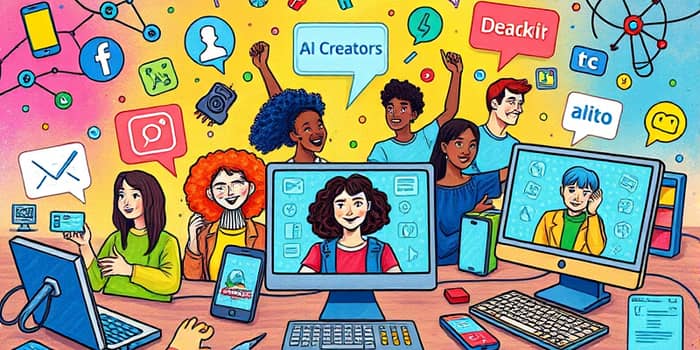
In 2025, social media has matured into a vast economic engine, where every swipe, share, and scroll holds potential for revenue generation. Platforms now compete not just for user attention, but for deeper engagement and lasting loyalty.
As advertising dollars shift increasingly toward digital experiences, these networks are at the forefront of defining how brands, creators, and communities interact in a connected world.
Global digital ad spending is projected to hit an astonishing $700 billion this year, marking a pivotal moment for marketers and platform owners alike. Social media ads now claim nearly 40% of this investment, translating to approximately $276.7 billion in 2025.
Meta, parent company of Facebook and Instagram, is poised to collect $183.8 billion from advertising alone—a 14.9% increase over the previous year—cementing its position as the second-largest digital ad revenue generator behind Google.
Mobile devices now drive 70% of total digital ad revenue, with further growth expected as high-speed 5G networks enable richer media formats and lower latency for immersive campaigns.
Experts predict that by 2029, mobile will account for 83% of all social media ad spend, reflecting the ever-growing dominance of smartphones and on-the-go connectivity in shaping consumer behavior.
To stand out in an increasingly crowded marketplace, platforms are investing heavily in advanced technologies and novel ad experiences that feel less like interruptions and more like integrated parts of the user journey.
Leading the charge is artificial intelligence. Platforms are harnessing AI for hyper-personalized content and ad delivery, tailoring every message to individual preferences and past behaviors. This level of customization has been shown to boost click-through rates and conversion metrics significantly.
Through predictive analytics to anticipate user behavior, social networks now time promotional prompts at moments of peak engagement—such as offering premium feature upgrades when a user is actively exploring a new tool or feature.
Immersive and interactive ad formats are also transforming the user experience. Rewarded ads granting extra game lives or bonus content incentivize users to voluntarily consume brand messages, creating a sense of reciprocity that traditional ads often lack.
Video advertising, supercharged by 5G connectivity, is outperforming other formats by 120%. 5G-powered fast and rich video ads deliver cinematic quality streams without buffering, making them a top choice for premium brand campaigns.
Underpinning these innovations is programmatic advertising, now responsible for 90% of all digital display ad buys. Through programmatic real-time AI-based ad buying, advertisers gain access to vast audiences with millisecond bidding decisions, ensuring precise targeting and budget efficiency.
Platforms are also experimenting with shoppable formats that allow users to complete purchases without leaving the app, bridging the gap between inspiration and transaction in a single, frictionless flow.
As ad models evolve, social platforms are reinforcing their commitment to creators by expanding direct monetization opportunities. This dual approach not only diversifies revenue streams for platforms, but also incentivizes high-quality content creation.
In 2025, more than $20 billion is redistributed annually through creator revenue sharing, reflecting the importance of content producers in driving user engagement.
YouTube’s refined partner program now welcomes channels with as few as 1,000 subscribers, provided they meet either 4,000 watch hours or 10 million Shorts views within 90 days. This shift has unlocked access for millions of emerging artists, educators, and influencers.
Shorts monetization and interactive ad formats enable short-form video creators to earn directly from micro-engagements, while shoppable video integrations elevate affiliate marketing by embedding product tags within clips.
On Instagram and Facebook, expanded ad revenue sharing for Reels and in-feed posts, combined with creator subscription features and bonus campaigns for viral content, have cultivated new avenues for recurring income.
Elsewhere, platforms such as TikTok and Twitch have refined tipping mechanisms, virtual gifting, and subscription tiers to foster closer connections between fans and their favorite creators, while ensuring a more predictable revenue base beyond fluctuating ad rates.
The table below highlights key monetization initiatives across five leading social platforms in 2025.
Beyond innovation, it is essential to measure how these strategies resonate with audiences and impact business outcomes.
These figures demonstrate a highly engaged public that responds positively to well-crafted ad experiences, even as the volume of messages continues to rise.
Since the inaugural banner ad in 1994, monetization has undergone a dramatic transformation—from static placements to algorithm-driven content feeds and immersive experiences.
The rise of the influencer marketing industry in the early 2010s further blurred the line between advertising and content, ushering in an era where authenticity and relatability became currency.
Platforms must navigate these challenges with transparency and accountability, building systems that empower users to understand how their data drives monetization efforts.
The platforms that will lead the next decade are those that blend technological prowess with a genuine commitment to human values—privacy, creativity, and community.
As creators leverage a tapestry of revenue streams, from ad shares to fan subscriptions and commerce collaborations, the ecosystem will become more resilient to market swings.
Ultimately, the most successful monetization strategies will be those that empower users and creators alike, viewing them not as data sources but as partners in a shared digital journey.
By embracing innovation with empathy and transparency, social media can continue to evolve as a force for connection, expression, and sustainable growth—where profit and purpose thrive side by side.
References













